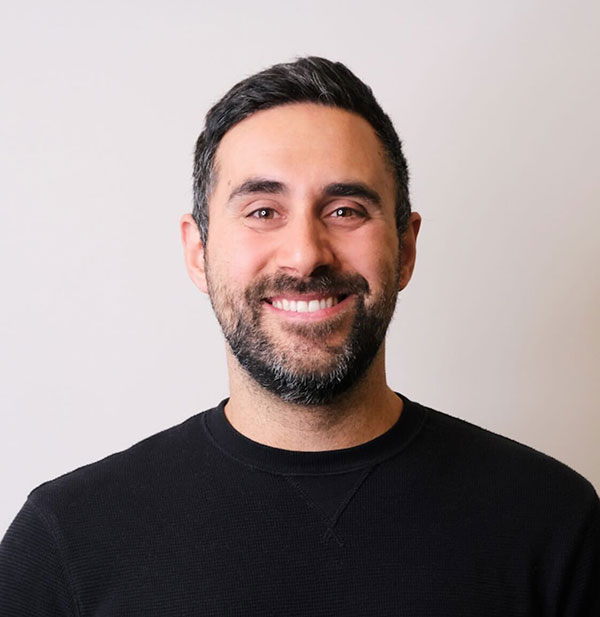How to invest without breaking the bank

With the stock market in a tailspin over the past few days, one of our guests, Nicolas Bérubé (article in French), would tell you not to touch your stocks, dear gentlemen. For his part, Ryan Serhant, one of the world’s leading real estate agents, recently called it a summer sale for investors. So let’s try to untangle all this, and how to get started to invest (it’s a great time of year, by the way) with Joey Kindarji, advisor and associate portfolio manager at Wealthsimple, a 100% digital Canadian investment management (and more) company.
Taking control of your personal finances

Joey Kindarji, advisor and associate portfolio manager at Wealthsimple
While you may be a beginner or an experienced investor, you may be wondering what the advantage of going to Wealthsimple is, which is exactly what I asked my guest. He tells me that people often start to invest with their bank, but with the recession and the prices being paid, people are more aware of what they’re paying everywhere, including bank fees (management fees, services received, etc.). “There are two important aspects when people think about personal finance: firstly, it’s short-term savings that come first, well before thinking about investments (e.g., emergency funds, vacations, unforeseen events, etc.). Secondly, it’s the long term, and here people are prepared to take a little more risk. In this type of investment, there are two aspects people need to think about: first, the reason for the investment (buying a house, a car, etc.), which will help determine the type of account to get, and, second, the management fees, which can affect your return,” adds Mr. Kindarji. Our guest tells us that Canada is one of the countries with the highest management fees, at 1% to 2% per year. On every $10,000, that’s still $200. On a portfolio that returns between 5% and 7% a year, that’s a third to a half of your investments going to management fees. “To offset these fees, at Wealthsimple, you have the choice of investing yourself in a brokerage account where Exchange Traded Funds (ETFs) are offered, or with the managed accounts where the team takes care of account management, a bit like in a traditional financial institution, but with 0.4% to 0.5% annual management fees,” adds the advisor.
Emergency fund: a necessity
“Coming back to the emergency fund, it’s important to keep 3 to 6 months’ worth of monthly expenses in a current account and not to take any risks with these funds, since savings accounts at major institutions only offer 1% to 2% interest per year, which is less than inflation. For example, at Wealthsimple, we’ve launched our ‘Cash’ account, a hybrid between a savings account and a chequing account (Interac transfers, direct deposit, physical card, etc.) that earns between 4% and 5% interest. If you have major financial obligations, such as mortgages, I suggest you have more of a 6-month than a 3-month emergency fund,” says Kindarji.
Want to sign up for Wealthsimple? Here’s how.

Wealthsimple desktop interface
You can either go to the website or via the mobile app. You choose the type of account, there’s no paper, it’s all digital. You can also transfer your account to the platform from your previous institution. “Once the transfer is done, we’ll send out the application, which can take a few days, and we refund transfer fees to people who transfer accounts over $15,000,” adds the finance expert.
Invest on your own or take advice?
There are clients who will invest in the same way as if we were managing their portfolio, i.e., reduce fees, rebalance and well diversify the portfolio, reinvest dividends to earn compound interest, and start as young as possible so that interest grows over time. Speaking of time, you need it to manage all your assets. And the third thing that’s hardest to quantify is psychological discipline, e.g.: are you going to invest in what’s very risky like GameStop or cryptocurrencies, for example? It’s okay to invest 5–10% of your money in high risk, but beyond that, an unrecoverable mistake could be fatal for your long-term investments,” clarifies the Wealthsimple veteran. In such cases, it’s best to hand over the reins of your personal finances to a professional.

Wealthsimple Mastercard credit card
“What we see is that even if people don’t have the knowledge, they want to learn. It can be fun to play, but it’s important to do it responsibly. Many of our customers use both, the self-managed platform for peace of mind and investing on their own to try it out. What’s more, at Wealthsimple, there’s no minimum amount to invest, and management fees start at 0.5% a year and can go down depending on how much you invest across your different accounts,” says the manager.
Although they don’t have “advice” on their platform itself, advisors are there for you, if you have a self-directed account, to give you advice on your investments and according to your portfolio to maximize your returns.
How to invest well?

Wealthsimple Mobile App
Mr. Kindarji tells us that the best way is not to put all your eggs in one basket, i.e., to invest in several companies in order to minimize risk, and this is the idea behind indices such as the S&P 500 (Standard & Poor’s), which includes the 500 biggest companies in the United States, but there are also the Dow Jones, the NYSE (New York Stock Exchange), the TSX (Toronto Stock Exchange), and many others. In our podcast, Mr. Bérubé talked about investing in the market.
The Wealthsimple expert adds that the ideal way to avoid depriving yourself for retirement is to create a budget to optimize your spending and plan ahead without depriving yourself too much. It’s certainly harder to save if you spend it all,” he says, “but the important thing is to find the right balance between spending and saving. If you don’t want to make a budget, the expert still advises us to save around 20% of our salary, and this action of saving helps people to have more discipline for later on. Speaking of discipline, like many other financial institutions, Wealthsimple offers automatic deposits, which he obviously advises making the day after you get your paycheque. You can even automate your ETF or stock purchases.
If digital banking scares you, find out more about Wealthsimple
The idea for Wealthsimple came from the current CEO and co-founder Michael Katchen. After working for a few years for 1000Memories, a Silicon Valley-based start-up acquired by Ancestry.com in 2012, he developed an Excel document containing tips to help friends build investment portfolios (ETFs, Stocks, etc.). The interest in this document is what inspired the idea of Wealthsimple since these friends wanted to invest, but didn’t want to invest their money themselves-they wanted it to be self-directed. In 2014, he returned to Toronto to launch the business. In December 2015, Wealthsimple merged with Canadian ShareOwner Investments Inc, a Canadian broker specialized solely in order execution. With this acquisition, Wealthsimple became the owner of one of Canada’s 14 discount brokerage firms, alongside other owners of discount brokerage firms, including Bank of Montreal and Royal Bank of Canada. The acquisition of Canadian ShareOwner Investment Inc. resulted in assets under management of C$400,000,000 across 10,000 client accounts. Investors such as Drake and Power Corporation also helped build confidence in the platform. Today, Wealthsimple manages over $40 billion in assets and 3 million clients in Canada. The English-speaking market dominates the company’s client base, of course, but Quebec, with its appetite for digital technology, is also embarking on the Wealthsimple adventure.
For Mr. Kindarji, who defines the platform according to 3 values, simplicity (the platform is easy to use), low management fees (everything starts at 0.5%) and accessibility (there is no minimum amount to start investing).
To deepen your knowledge, Mr Kindarji recommends 3 books either A Random Walk Down Wall Street: The Best Investment Guide That Money Can Buy de Burton G. Malkiel, The Wealthy Barber: The Common Sense Guide to Successful Financial Planning de David Chilton and, to conclude, Millionaire Teacher: The Nine Rules of Wealth You Should Have Learned in School de Andrew Hallam.




